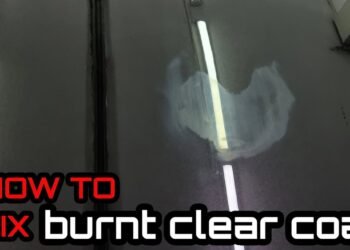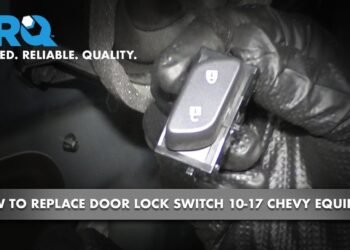If your Dodge Ram 1500 has been giving you trouble with its electronic throttle control, you’re not alone. That warning light on your dashboard can leave you feeling frustrated and even a little worried about costly repairs.
But here’s the good news: fixing electronic throttle control issues doesn’t have to be overwhelming. In fact, with the right guidance, you can understand what’s going on and take steps to get your truck running smoothly again. Imagine getting back on the road without worrying about sudden stalling, poor acceleration, or those annoying warning lights.
This guide is here to help you do exactly that. We’ll break down everything you need to know in simple, clear steps. Whether you’re a DIY enthusiast or just looking to understand what your mechanic is talking about, this article is your go-to resource. Stick around, and let’s get your Dodge Ram 1500 back to performing at its best!

Credit: www.youtube.com
Common Symptoms Of Throttle Control Issues
Electronic throttle control issues in a Dodge Ram 1500 can sneak up on you, but the symptoms are often glaring once you know what to look for. Ignoring these signs can lead to bigger problems and costly repairs. Let’s break down the most common symptoms so you can identify the issue early and take action.
Unresponsive Acceleration
Have you ever pressed the gas pedal and felt like nothing happened? This is a classic sign of throttle control problems. The engine might hesitate or fail to respond altogether, making it difficult to maintain speed or overtake other vehicles.
It can be frustrating, especially when driving in traffic or on highways. If you notice this consistently, the electronic throttle control system could be the culprit. You might want to check for any loose connections or damaged wiring before heading to a mechanic.
Warning Light Indicators
That dreaded dashboard light can be your first clue. If the electronic throttle control warning light (often shaped like a lightning bolt) appears, it’s a clear indication that something’s off. Sometimes, the check engine light might also come on, adding to the urgency.
Don’t ignore these warnings, even if the truck seems to drive fine. The onboard diagnostic system is picking up an issue that needs your attention. Use an OBD-II scanner to get a clearer picture of the problem, or have a professional check it out.
Erratic Engine Performance
Does your truck stall or surge unpredictably? Erratic engine behavior is another telltale sign of throttle control issues. You might notice the engine revving too high or shutting off unexpectedly, making it hard to trust your vehicle.
These symptoms often happen at the worst times, like when you’re merging onto a freeway. Fixing the throttle control could save you from dangerous situations and restore your truck’s reliability. Regular maintenance of sensors and cleaning the throttle body can often prevent these issues.
Are you experiencing any of these symptoms in your Dodge Ram 1500? Identifying the problem early can save you time, money, and stress. Take action today to get your truck running smoothly again.
Tools And Equipment Needed
Fixing the electronic throttle control on your Dodge Ram 1500 isn’t as intimidating as it may sound. The key is having the right tools and equipment ready before you roll up your sleeves. Whether you’re a seasoned DIYer or just trying to save some money on repairs, having the essentials on hand can make the process smoother and less stressful.
Basic Hand Tools
Start with the basics. You’ll need a standard socket set, screwdrivers, and wrenches—nothing fancy. A good pair of needle-nose pliers can also come in handy for dealing with small connectors or wires.
Make sure your tools are well-maintained. A loose wrench or worn-out screwdriver can easily strip bolts or screws, and that’s the last thing you want while working on your truck.
Tip: Keep a magnetic tray nearby to hold screws and bolts. You’ll thank yourself when you’re not crawling on the garage floor looking for lost pieces.
Obd-ii Scanner
An OBD-II scanner is your best friend for diagnosing throttle control issues. If you don’t already have one, consider investing in a quality scanner that can read and clear error codes.
Plug it into your truck’s diagnostic port (usually under the dashboard on the driver’s side) and look for any relevant codes related to the throttle control system. These codes will point you in the right direction.
Don’t skip this step—it saves you from blindly guessing the problem and potentially replacing parts unnecessarily.
Replacement Parts
Before you start, confirm what parts you’ll need. Common replacements for throttle control issues include the throttle body, sensors, or wiring harness. Check your truck’s manual or use the OBD-II scanner to identify faulty components.
Buy high-quality parts that match your truck’s make and model. Cheap knock-offs might fit, but they often fail quickly, leaving you back at square one.
Pro Tip: Keep the receipts. Some stores offer returns or exchanges if the part doesn’t solve your issue.
Having these tools and equipment ready makes the repair process far less frustrating. What’s your go-to tip for organizing tools while working on your truck? Share it in the comments!
Preparing Your Vehicle
Before fixing the electronic throttle control on your Dodge Ram 1500, it’s crucial to prepare the vehicle properly. Proper preparation ensures safety and helps the repair go smoothly. Skipping these steps could lead to serious issues or even injuries. Take your time and follow each step carefully.
Ensuring Safety Measures
Start by parking your truck on a flat surface. Use wheel chocks to prevent any movement. Engage the parking brake to ensure extra stability. Wear protective gloves and safety glasses to avoid injuries. Make sure the engine is completely cool before starting any work.
Disconnecting The Battery
Open the hood and locate the battery. Use a wrench to loosen the negative cable clamp. Disconnect the negative cable first to avoid electrical shocks. Secure the cable away from the battery to prevent accidental contact. Repeat the process for the positive cable if needed.
Locating The Throttle Control System
Find the throttle body under the hood. It’s typically between the air filter and intake manifold. Consult your vehicle manual for exact location details. Look for the throttle control module connected to the throttle body. Ensure all surrounding components are clean and accessible.
Credit: www.ram1500diesel.com
Diagnosing The Problem
Electronic throttle control issues in a Dodge Ram 1500 can cause serious driving problems. Diagnosing the issue is the first step toward fixing it. Identifying the root cause saves time and prevents unnecessary repairs. Below are key steps to diagnose the problem effectively.
Using An Obd-ii Scanner
Start by connecting an OBD-II scanner to your truck’s diagnostic port. This tool reads error codes from the vehicle’s computer system. Look for codes related to the throttle control, such as P2111 or P2112. Write down the codes and their descriptions for reference. A scanner can also clear codes after the issue is resolved.
Inspecting Throttle Body Components
Turn off the engine and locate the throttle body. Check for dirt, carbon buildup, or physical damage on the throttle plate. A dirty throttle body can restrict airflow, leading to performance issues. Clean it using throttle body cleaner and a soft cloth. Inspect the throttle position sensor for wear or damage. Replace it if necessary.
Checking Wiring And Connections
Examine the wiring connected to the throttle body for any visible damage. Look for frayed wires, loose connections, or corrosion on connectors. Secure any loose connections and repair or replace damaged wires. Faulty wiring can disrupt communication between the throttle and the engine control unit.
Cleaning The Throttle Body
The electronic throttle control in your Dodge Ram 1500 can sometimes malfunction due to dirt buildup. Cleaning the throttle body is one of the most effective ways to restore smooth operation. Dirt, carbon, and grime can collect inside the throttle body, affecting airflow and performance. A clean throttle body ensures proper communication between the accelerator pedal and the engine. Follow these steps carefully to clean it and improve your truck’s performance.
Removing The Throttle Body
Before starting, disconnect the negative terminal of the battery to avoid electrical issues. Locate the throttle body, usually between the air intake and the engine. Remove the air intake hose by loosening the clamps. Unscrew the bolts holding the throttle body in place using a wrench. Disconnect any sensors or wiring attached to the throttle body. Be gentle while handling the sensors to prevent damage.
Using Throttle Cleaner Spray
Place the throttle body on a clean surface. Spray throttle cleaner inside the body to remove dirt and carbon buildup. Use a soft brush or lint-free cloth to scrub stubborn grime. Avoid damaging the sensors or electrical components while cleaning. Let the throttle body air dry for a few minutes before reinstalling.
Reinstalling The Throttle Body
Reconnect any sensors or wiring you removed earlier. Place the throttle body back in its position and secure it with bolts. Attach the air intake hose and tighten the clamps. Finally, reconnect the battery terminal and start your vehicle. Check for smoother acceleration and improved engine response after cleaning.

Credit: www.youtube.com
Replacing Faulty Components
Fixing the electronic throttle control on your Dodge Ram 1500 often means replacing faulty components. While it might seem intimidating, breaking it down step by step makes the process manageable. Let’s focus on identifying damaged parts, installing a new throttle body, and testing your replacement to ensure everything works smoothly.
Identifying Damaged Parts
Before you start replacing anything, you need to pinpoint the issue. Common signs of a faulty throttle control include a lack of acceleration, poor fuel efficiency, or the dreaded check engine light. Use a diagnostic scanner to pull up error codes—they can guide you to the exact problem.
Inspect the throttle body for visible damage like carbon buildup or stuck valves. Don’t forget to check the wiring harness and connectors for signs of wear, corrosion, or looseness. A quick visual inspection can save you from unnecessary replacements.
Ask yourself: does the part look beyond repair, or can cleaning and minor adjustments solve the issue? Knowing this will help you decide your next step.
Installing A New Throttle Body
If you’ve confirmed the throttle body needs replacing, it’s time to get your tools ready. Disconnect the negative battery terminal first—it’s a basic but crucial safety step. Then, detach the intake air hose and remove the bolts securing the throttle body to the intake manifold.
Carefully install the new throttle body, ensuring the gasket is properly aligned to avoid air leaks. Tighten the bolts evenly and reconnect the electrical connectors. Double-check everything before moving on to avoid redoing steps later.
Take your time during installation. A rushed job can lead to misalignment or overlooked connections, causing more problems down the line.
Testing The Replacement
Once the new throttle body is in place, reconnect the battery and turn on the ignition without starting the engine. This allows the electronic throttle control system to recalibrate. Listen for any unusual sounds and ensure no warning lights appear on the dashboard.
Next, start the engine and let it idle for a few minutes. Pay attention to how it runs—does it sound smooth, or is it struggling? Finally, take your truck for a short test drive to confirm that acceleration and throttle response have returned to normal.
Testing isn’t just about confirming the fix. It’s also about catching any small issues early before they become major headaches. Would you rather find a loose connector now or be stranded later?
Replacing faulty components in your Dodge Ram 1500 doesn’t have to be overwhelming. By breaking it down into these clear steps, you’ll save time, frustration, and potentially a costly trip to the mechanic.
Resetting The Throttle Control System
The throttle control system in your Dodge Ram 1500 is essential for smooth acceleration and overall performance. Sometimes, issues arise that require resetting the system to ensure your truck runs like new. Resetting the throttle control isn’t complicated, but it does involve a few key steps you need to follow carefully. Let’s dive into the process, step by step.
Reconnecting The Battery
Start by disconnecting the battery. This step is crucial because it cuts off power to the electronic throttle control system, forcing it to reset.
Wait for about 15 minutes before reconnecting the battery. This pause ensures that all electrical components fully discharge.
When reconnecting, make sure the terminals are clean and securely attached. A loose connection can cause more problems down the road.
Performing A Throttle Relearn Procedure
Once the battery is reconnected, turn the ignition to the “ON” position without starting the engine. This allows the system to begin recalibrating.
Press the accelerator pedal all the way down, then release it completely. Repeat this action two to three times to help the system relearn the throttle range.
Start your engine and let it idle for about 5 minutes. During this time, avoid pressing the gas pedal. This idle period helps the system stabilize.
Ensuring Proper Calibration
After the relearn procedure, take your truck for a short drive. Pay attention to how the throttle responds—does it feel smooth and consistent?
If you notice hesitation or uneven acceleration, repeat the relearn steps. Sometimes, it takes a few tries for the system to fully adjust.
Keep an eye on the dashboard. If the throttle control warning light remains on, double-check your connections and procedures to ensure everything was done correctly.
Resetting the electronic throttle control system in your Dodge Ram 1500 doesn’t require a trip to the mechanic. By following these steps, you can restore proper function and enjoy a smoother driving experience. Have you tried resetting your throttle control before? What worked for you?
Tips For Preventing Future Issues
Fixing electronic throttle control on a Dodge Ram 1500 is essential. Once repaired, proper care can help prevent future issues. Regular checks and mindful habits ensure the system works smoothly. Below are practical tips to maintain your vehicle’s throttle control.
Regular Maintenance Practices
Inspect the throttle body during routine vehicle servicing. Dirt buildup can impact performance. Clean the throttle body using appropriate cleaning solutions. Check for loose or damaged wiring connections. Ensure all sensors related to the throttle are in good condition. Replace faulty sensors promptly to avoid further complications.
Schedule periodic diagnostic tests to monitor system health. These tests can detect minor issues before they become major problems. Follow the manufacturer’s recommended maintenance schedule for your Dodge Ram 1500.
Using High-quality Fuel
Use high-quality fuel to reduce deposits inside the throttle system. Low-grade fuel may lead to carbon buildup, affecting performance. High-quality fuel burns cleaner and helps maintain engine efficiency. It also reduces the risk of sensor malfunction.
Stick to fuel brands recommended for your vehicle. Avoid mixing different types of fuel. Ensure the tank is free from water contamination or debris.
Monitoring Warning Signs
Pay attention to dashboard warning lights related to the throttle control. If the electronic throttle control light appears, investigate immediately. Delayed action can lead to more serious engine problems. Notice unusual changes in acceleration or idling. Slow response or stalling may indicate throttle control issues.
Listen for abnormal sounds during driving. Clicking or grinding noises could signal trouble with the throttle system. Address these signs early to avoid costly repairs later.
Frequently Asked Questions
What Causes The Electronic Throttle Control To Fail In Dodge Ram 1500?
Faulty sensors, wiring issues, or software glitches can cause electronic throttle control failure in Dodge Ram 1500.
How Do I Reset The Electronic Throttle Control On A Dodge Ram 1500?
Turn the ignition on, press the gas pedal slowly, release, and turn the ignition off to reset.
Can I Drive My Dodge Ram 1500 With A Throttle Control Warning?
Driving with a throttle control warning can be unsafe. Fix the issue as soon as possible.
How Much Does It Cost To Repair Electronic Throttle Control In Dodge Ram 1500?
Repair costs vary but generally range between $300 to $600 depending on labor and parts.
What Tools Are Needed To Fix Electronic Throttle Control Issues?
Basic tools like a wrench, diagnostic scanner, and screwdriver are typically needed for electronic throttle control repairs.
Conclusion
Fixing the electronic throttle control on a Dodge Ram 1500 takes patience. Start by identifying the problem through error codes or symptoms. Common fixes include cleaning the throttle body or replacing faulty sensors. Always double-check connections and reset the system after repairs.
Regular maintenance can prevent future issues and improve performance. If the problem persists, consult a professional for help. Addressing the issue early can save time and money. A well-functioning throttle control ensures smoother drives and better fuel efficiency. Stay proactive, and your truck will keep running strong.

















